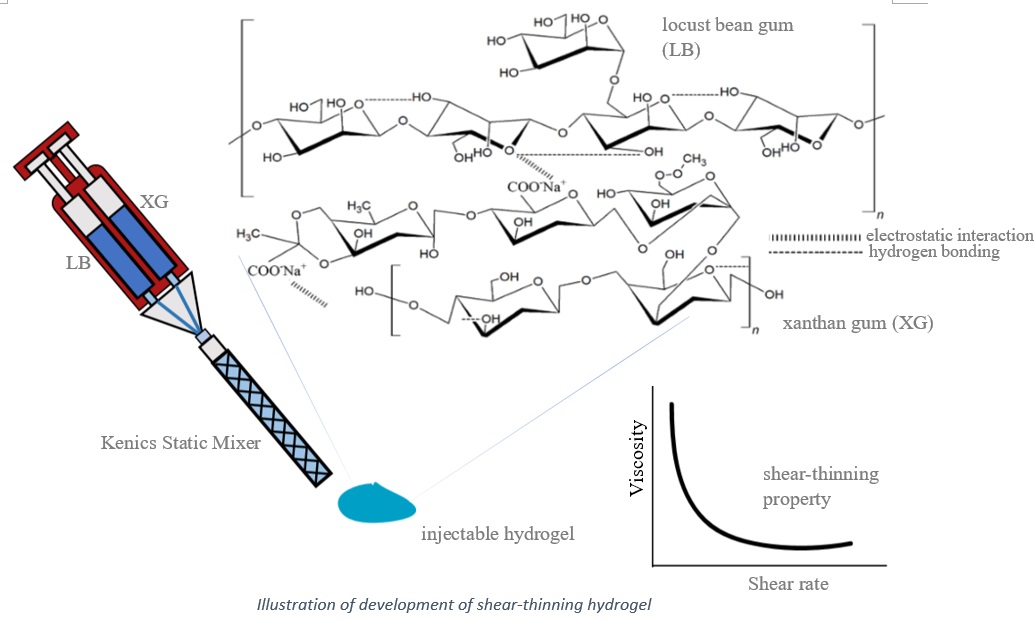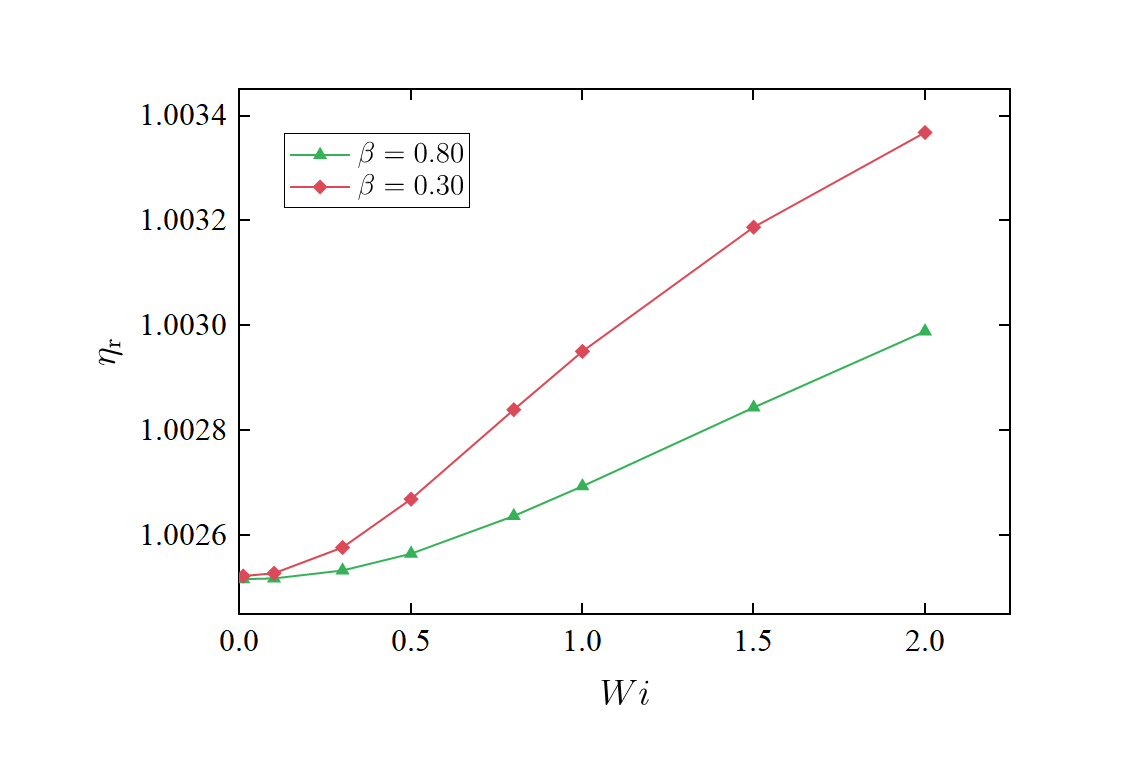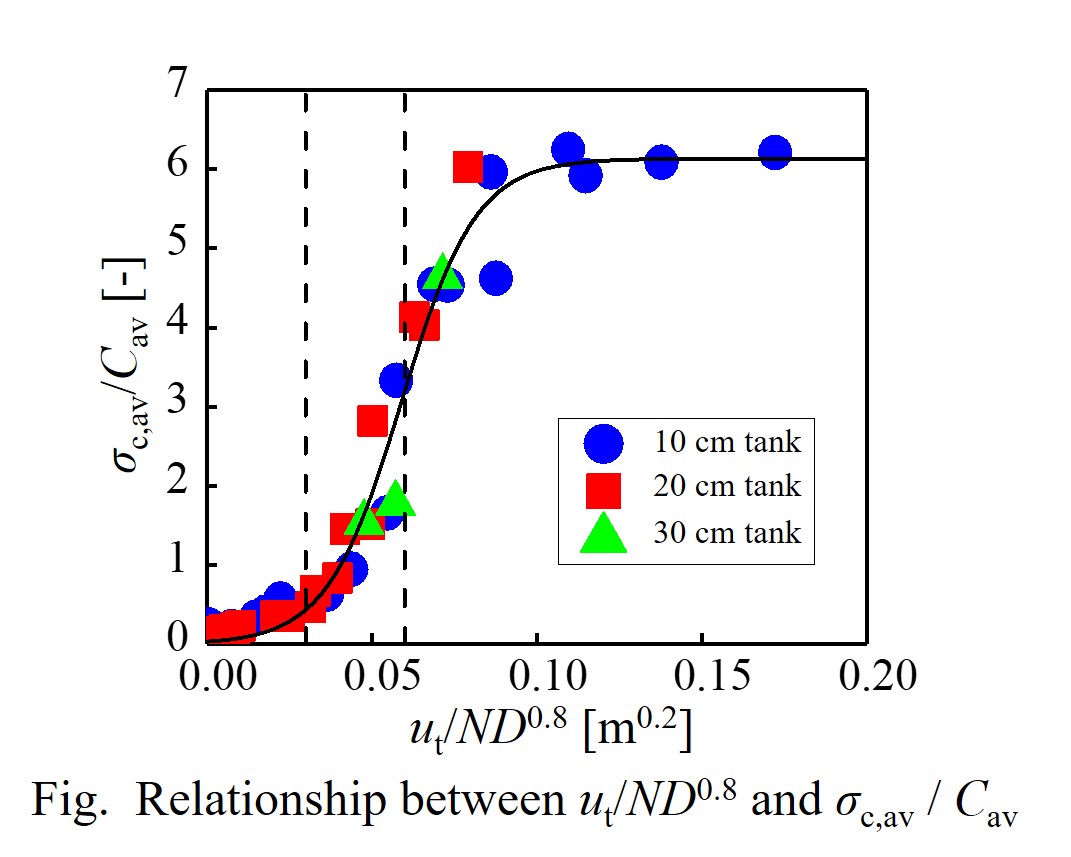
A mixing performance of an inner baffle was investigated in shear thinning fluid. The inner baffle was placed with a clearance between baffle and vessel wall. A traditional two-bladed paddle impeller was used. Four planar baffles was vertically placed in two ways: 1) standard baffle condition 2) baffle condition with a clearance between baffle and vessel wall. A mixing pattern was visualized by decolorization method based on an oxidation-reduction reaction with sodium thiosulfate and iodine. Flow field for shear thinning fluid in mixing vessel was measured by particle image velocimetry and was shown as stream line. An isolated mixing region (IMR) like doughnut ring formed under standard baffle condition, however, IMR dissipated when baffles were placed with a clearance between baffle and vessel wall. As a result, mixing time was drastically decreased. This study suggested that inner baffle promoted mixing in shear thinning fluid.
Injectable hydrogels are widely used for minimally invasive therapy. Among injectable hydrogels, shear thinning hydrogels have received much attention recently, as their viscosity decreases with increase in shear rate making it suitable for flow through long channels. Static mixers enable efficient mixing without an external energy source, and thus have been used for the fabrication of injectable hydrogels, such as dental impression materials. However, gelation behavior of shear thinning hydrogels in static mixers is still unknown. In this research, we study the shear-thinning behavior of hydrogels formed by physically cross-linking natural polysaccharides, such as xanthan gum and locust bean gums using a Kenics Static Mixer.
Mixtures of 1 wt% xanthan gum and 1 wt % locust bean gum in pure water formed hydrogel by mixing in static mixer with 16 elements at axial velocity of 100 mm/s. The mechanical strength of the formed hydrogels was measured using a rheometer. G' value for xanthan gum to locust bean gum ratio of 1:1 was found to be 18 Pa. The mechanical strength can be increased by increasing ionic strength. The pressure drop dependence on mixing conditions and hydrogel composition at different polymer ratios was characterized using the static mixer. An increase in axial flow velocity and number of mixing elements showed an increase in average pressure drop due to hydrogel formation. Furthermore, the viscosity of formed hydrogels decreased with increasing shear rates from 1.9 to 383 s-1 and was fitted to the power law model for non-Newtonian fluids. These results indicated shear-thinning property of hydrogels, which would be owed to the nature of physical crosslinkings. Pressure drop dependence of the above parameters will be discussed using non-dimensional Deborah number defined as the ratio of time taken by materials to adjust to applied stresses to characteristic time scale of an experiment.

Particle suspensions in viscoelastic fluids such as polymer solutions or polymer melts are broadly used in industrial products. Understanding the rheology of them is essential for proper manufacturing operations. Among viscoelastic fluids, so-called Boger fluids are widely utilized for separately examining the effect of elasticity of the fluids due to the constant shear viscosity. In past experimental studies, suspensions in Boger fluids are reported to show the shear-thickening in the apparent suspension viscosity even at dilute suspensions[1]. To clarify the mechanism of this thickening, numerical studies were reported[2].
We studied unclear effects of fluid elasticity on the shear-thickening in dilute suspensions using newly developed direct numerical simulation based on Smoothed-Profile Method[3]. Oldroyd-B model, which represents the shear flow rheology of Boger fluids well, is utilized in our calculations. The fluid elasticity is quantified by the Weissenberg number (Wi) and the viscosity ratio between the solvent and polymer (beta). A small beta corresponds to a high polymer concentration or a high-molecular-weight polymer (strong elasticity of fluid).
We clarified that the modulation of the velocity field of the host fluid due to the polymer stress, which is more pronounced in lower beta conditions, relax the level of the polymer stress concentration, resulting in the non-trivial weakening of Wi-dependency of the shear-thickening in the normalized suspension viscosity observed in a high Wi region in the figure. This result indicates that the two parameters measuring the fluid elasticity has counter-acting effects on the suspension rheology and are essentially important for suspension phenomena in moderate or strong viscoelastic fluids such as non-dilute polymer solutions or polymer melts.
[1] R. Scirocco et al., J. Rheol. 49, 551 (2005)
[2] M. Yang and E. S. G. Shaqfeh, J. Rheol. 62, 1363 (2018)
[3] Y. Nakayama et al., Eur. Phys. J. E 26, 361 (2008)

In the mixing operation, the flow pattern in the turning space of the stirring blades affects the circulation flow in the tank and is directly linked to the success or failure of the mixing operation. However, the flow pattern in the turning space is not clarified because measurement in the turning space is difficult. Especially in the transitional regime, the effect of vessel size and fluid viscosity have not been understood. Although computational fluid dynamics (CFD) is very useful technique to predict fluid flow, validation with experimental data is essential.
In this study, the three-dimensional flow velocity distribution in the turning space of the six-blade paddle in a non-baffled vessel from laminar, transitional to turbulent regime was quantified by CFD using ANSYS Fluent 18.0. Laminar, transition-SST, and LES model were used for each flow regime. In addition, the velocity distribution in the turning space was quantified by two-dimensional particle image velocimetry (2D-PIV) with the transparent impeller. The flow velocity data were converted from a Cartesian coordinate system into a rotational cylindrical coordinate system synchronized with the rotation of the blades. The flow velocity distribution of CFD results were validated by PIV data.
As a result, it was found that the discharge flow of the fluid shifted from the front side to the back side of the blade as the flow regime change from laminar, transitional to turbulence. Moreover, the fluid velocity faster than the rotational speed of the blade was observed in the back space of the blade in the transitional regime, and it was found that a negative pressure area was formed. The organized vorticity motion was formed in the back space of the blade not only in the turbulence but also transitional regime.

Solid-liquid mixing is widely used in crystallizer and chemical reactor with catalysis. In these processes, there is a problem that solid particles aggregate and collide with a stirring blade. The particle collision causes particle breakage and abrasion. Furthermore, when scaling up to the scale of industrial equipment, the particle dispersion state usually becomes insufficient. It is important to quantify the solid particle concentration distribution in the tank and grasp the dispersion state to solve these problems. However, it is difficult to measure the detailed particle concentration in the tank under many conditions. So, in this study, Euler-Lagrangian simulations were performed with various particle diameter, particle density, impeller speed N, Impeller diameter D, and tank diameter to quantify the vertical distribution of solid particle concentration in the vessel and identified the factor that determines the dispersion state.
The Euler-Lagrangian approach, which tracks all particle motion, was adopted. Turbulent flow in the vessel was represented by LES. The interactions of particle–particle and particle–solid surfaces were modeled using the distinct element method. Analysis was performed by changing the vessel diameter, impeller speed, particle diameter and particle density to 3 conditions respectively. The fluid was presumed to be water. The standard deviation of particle concentration in the vertical direction, σc, was calculated and time averaged σc, σc,av, was used as the evaluation index of dispersion state in the vessel.
It was found that σc,av/Cav was correlated with the value ut/ND0.8 obtained by dividing terminal velocity of single particle ut by impeller speed N and D0.8. This result showed that the uniformity of particle concentration in the vertical direction can be ordered by the ratio of ND0.8 to ut regardless of the particle property, impeller speed and vessel size.

Mixing is one of the critical processes in the industry. One of the operating units used in the mixing process is a stirred tank. The efficiency of the stirred tank is greatly influenced by several factors including stirred tank design, operating conditions, and working fluid properties. The side-entry stirred tank is widely applied in the industrial process of crude oil in the refinery industry, water-molasses mixing in the bioethanol industry, pulp stock chest in the pulp and paper industry, and anaerobic digester for biogas reactors. Mixing time is one of the key parameters used in the design of a stirred tank. This research will model mixing time in a flat bottom cylindrical side-entry stirred tank with dimensions D = 40 cm and T = 40 cm using CFD ANSYS 18.2 by applying the RKE and SKE turbulence models. The stirrer used is three-blade marine propeller d = 4 cm which is an axial type impeller. The phenomenon of mixing in a side-entry stirred tank, qualitatively described through computational prediction results in the form of flow profiles and tracer density change contours locally. Moreover, quantitatively indicated by mixing time validated using experimental data carried out by the conductometry method. The simulation results show that the mixing time modeled with the SKE turbulence model shows a similarity level of 68.16%, while the RKE turbulence model shows 31.94%.